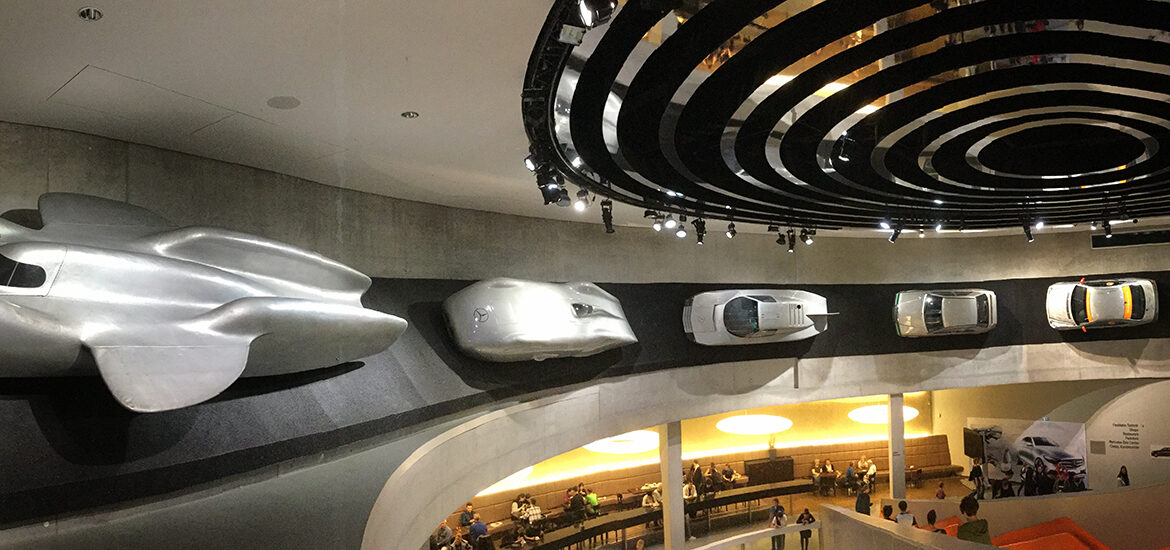October 2, 2016: On Sunday morning, we continued our journey, and it was our first Sunday in Germany. We were struck by how eerily empty the streets of Nuremberg were. It was quite unusual compared to Russia, where weekends are a lively affair with people flocking to cafes and museums. In Germany, even the grocery stores were closed! Thankfully, the trains were running on schedule, and we enjoyed a smooth ride to our next stop, Stuttgart.
Our excitement grew as we arrived in Stuttgart, where a friend from our student dormitory awaited us. The city felt livelier than Nuremberg, with its rolling hills and a mix of historical and modern development—definitely a curious sight!
The highlight of our visit was the Mercedes-Benz Museum. Now, I’m not a car enthusiast—Mercedes-Benz was never my thing. But wow, the museum was quite an experience! I was there with two friends who were completely mesmerized by the vintage cars. They gazed at them with such awe, and it was almost charming how they were allowed to touch the exhibits. Me? I was more of a casual observer, though I must admit, the beauty of these classic cars was undeniable.
The museum offers audio guides in various languages, but I quickly lost interest in the deluge of technical details about engines. I enjoyed strolling past glossy cars but found the engine talk a bit tedious. However, there were some standout moments.
The tour begins on the 9th floor with a display starting with a horse—a symbolic nod to the horsepower that led to the development of cars. Nearby, there’s a quote from Kaiser Wilhelm II: “I believe in the horse. The automobile is a temporary phenomenon.” Ironically, his own car is part of the exhibit!
The “Pioneers” section covers the birth of the automobile. I was surprised to see how many famous names were involved in Mercedes-Benz’s history. For instance, Gottlieb Daimler and Carl Benz created the first cars in 1886. Daimler even ordered engines from Wilhelm Maybach, showcasing an early example of collaboration among big names. Seeing these antique vehicles, it was hard to believe they were once street-ready. They had a charming, if somewhat unsafe, allure.
The “Mercedes—Birth of the Brand” section displayed colorful retro cars from 1900 to 1914. It was a time of significant growth for Mercedes-Benz, partly thanks to Ferdinand Porsche’s contributions. The brand’s name evolved from DMG (Daimler-Motoren-Gesellschaft) and Benz & Cie. to “Mercedes,” named after Emil Jellinek’s daughter. It’s fascinating how this name became synonymous with luxury and prestige worldwide.
In the “Times of Change—Diesel and Supercharger” section, I learned about innovations like the supercharger, which was developed for aircraft engines during World War I and later adapted for cars. The vehicles from this era reminded me of old cartoons like Tom & Jerry—a nostalgic connection, considering these cars predated anything I’d seen in Russia.
The “Post-war Miracle—Form and Diversity” section covered 1945 to 1960. The cars from this period didn’t wow me, but it was intriguing to see how Mercedes-Benz vehicles became symbols of the German economic miracle, embodying quality and elegance.
The “Visionaries—Safety and the Environment” section focused on innovations from the 1960s and 1970s. While the designs of this period didn’t excite me, it was impressive to see how Mercedes-Benz led the way in safety and environmental technology, introducing features like ABS and airbags.
The “New Beginning—The Road to Emission-free Mobility” section showcased advancements in electric and alternative propulsion technologies. I’ve always believed that electric cars are the future, and seeing the early prototypes in this exhibit reinforced that belief.
The “Silver Arrows—Races & Records” section was a revelation. I never associated Mercedes-Benz with racing, but their history in motorsport is impressive. The legendary Silver Arrows and their many victories in Formula One and other racing events showcased the brand’s performance and innovation. It was a surprise to learn that trucks were also involved in racing!
My favorite parts of the museum were the “Gallery of Voyagers” and the “Gallery of Carriers.” The “Gallery of Voyagers” featured unique vehicles like the 1907 Milnes-Daimler double-decker bus and the cheerful 1969 Mercedes-Benz Bus LO 1112 from Argentina. I was amazed at how they managed to park these buses so perfectly close to each other. The 1969 bus, in particular, looked like it was ready for a dance party!
The “Gallery of Carriers” showcased trucks and vans, starting with Gottlieb Daimler’s 1896 truck. These vehicles revolutionized goods transport and were crucial during the post-war economic recovery. Seeing these early models highlighted how much Mercedes-Benz has contributed to transportation.
The “Gallery of Celebrities” and “Gallery of Everyday Heroes” didn’t impress me as much. The “Gallery of Celebrities” displayed luxury cars owned by famous figures, including a surprisingly fascinating popemobile. The “Gallery of Everyday Heroes” featured practical, reliable vehicles, but they didn’t leave a lasting impression.
Leaving the museum, I felt a mix of admiration and surprise. Despite not being a fan of Mercedes-Benz, I gained a newfound respect for the brand’s history and its impact on the automotive world. The museum was a testament to the innovation and effort that shaped the cars we see on the streets every day. It was definitely worth the visit!
